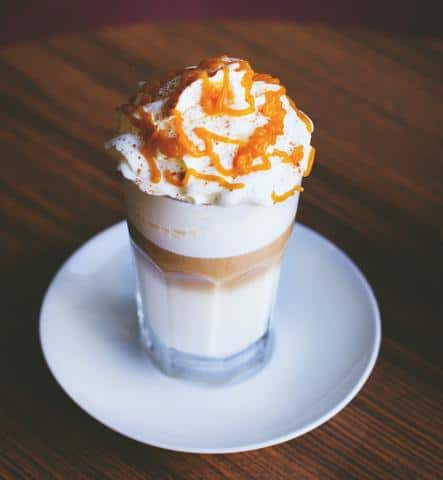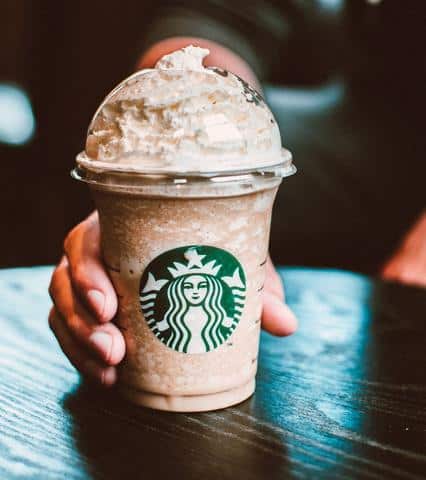Translated into English, the French word “Frappé” means “iced.” The word originated in the middle of the 19th century to describe just about any type of partially frozen beverage (including fruit juice, but even liqueurs served over shaved ice!) but today, is mostly associated with cold coffee beverages. This begs the question – what made frappés a popular fixture at coffee shops? Well, we can attribute that to the Greeks.

For your information, if you click on a product on Jayarrcoffee.com and decide to buy it, we may earn a small commission.
Table of Contents
Coffee Frappé Origins
References to cold coffee beverages with the name “Café Frappé” began showing up in the middle of the 19th century. A number of those drinks had slushy consistencies, while others resembled coffee served with cubed ice. But in 1957, the Greeks came up with a variation of a frappé through the use of instant coffee. This version of the drink went on to receive widespread popularity that is still widely seen today.

It’s believed that a Nestlé company representative was demonstrating how to make an instant chocolate drink for kids. He mixed milk with a chocolate base before shaking it all up. Inspired by this new chocolate drink, a colleague of his, after not being able to find hot water, decided to mix instant granules of coffee with ice cubes and cold water inside of a shaker. The outcome was the genesis of the frappe we enjoy today.
Frappé Variations
After café culture exploded internationally, coffee shops took out all the stops in trying to entice new customers, working hard to differentiate their beverages from those offered by the competition. Variations of the frappé filled cafés everywhere!

Although Greeks prefer to drink traditional versions of frappés and use coffee granules (instant) to make them, just about everyone else in the world seems to prefer using espresso. Ice and sugar is shaken with a double espresso just before being served. Several coffee shops might also add Kahlua – among other liqueurs – to the drink, while others prefer topping theirs off with ice cream. Bulgarians prefer to shake frappés up with cola rather than water. People in Denmark use cold milk rather than water. Serbians commonly use ice cream and often add whipped cream as well.
Conventional Versus Contemporary Preparation
The Greek version of a frappé isn’t hard to make. Using either a mixer or cocktail shaker, combine up to two spoonfuls of coffee granules (instant), a little bit of water, and a pinch of sugar. The shaker will produce the frothy layer frappés are known for. Milk is a common addition to the frappé.
The coffee shop version of a frappé is made with a blender. Generally, some water, strong coffee, sugar, milk, ice, and syrups/alcohol (if desired) are dumped into the blender, blended, and poured into a tall glass. Common toppings include chocolate syrup, whipped cream, or even ice cream!
Are Frappés and Frappuccino’s the Same Thing?
“Frappuccino” is a portmanteau of “cappuccino” and “frappé” (pronounced without an accent – “frap”).
In Boston, where the frappuccino originated, “lait frappés” are denser coffee milkshakes. A coffee shop in eastern Massachusetts called “The Coffee Connection” developed and trademarked their own version of the frappuccino, made by mixing coffee with a milkshake, and sold it to the public. After Starbucks purchased “The Coffee Connection” in 1994, they owned legal rights to produce, market, and sell the beverage as a frappuccino.

Starbucks modified the recipe a little after introducing it to their menu and it remains a top seller for them, particularly during the warmer months of the year. The recipe now uses a Frappuccino roast specifically formulated for being used cold, a Frappuccino “base” made from sugar, flavor, water, a thickening agent, coloring, and caffeine, milk, and ice. The Frappuccino roast is first added. Whole milk (or non-dairy milk substitute if desired) is added to bottom line of the Starbucks cup. These two ingredients are added to the blender along with the appropriately flavored Frappuccino “base”, along with any additional syrups or inclusions. Finally, ice is added and the beverage is blended.

Starbucks also offers a bottled flavored coffee sold under the name “Frappuccino” which is a different drink than the Frappuccino sold in-store.
Nutritional Content of the Starbucks Frappuccino
Great as it may taste, the Starbucks Frappuccino is a truly calorie-intensive beverage. A standard grande (16 oz) Frappuccino with no add-ins and no whipped cream contains 230 calories- with 3 grams of fat and 45 grams of sugar.

The bottled coffee that Starbucks sells under the name “Frappuccino” is actually more calorie dense – a 9.5 oz bottle contains 200 calories- with 3 grams of fat and 31 grams of sugar.

In Closing…
Frappés are quite a satisfying beverage to consume, especially on a hot summer day. Baristas all over the world give the drink their own unique spin, and at least one of them is sure to blow you away. Next time you are in your favorite cafe, try out a frappé!
